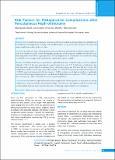Please use this identifier to cite or link to this item:
https://hdl.handle.net/20.500.14356/1604| Title: | Risk Factors for Postoperative Complications after Percutaneous Nephrolithotomy |
| Authors: | Basnet, Robin Bahadur Shrestha, Anil Shrestha, Parash Mani Joshi, Bishwa Raj |
| Citation: | BasnetR. B., ShresthaA., ShresthaP. M., & JoshiB. R. (2018). Risk Factors for Postoperative Complications after Percutaneous Nephrolithotomy. Journal of Nepal Health Research Council, 16(1), 79-83. https://doi.org/10.33314/jnhrc.v16i1.1114 |
| Issue Date: | 2018 |
| Publisher: | Nepal Health Research Council |
| Article Type: | Original Article |
| Keywords: | Clavien score Complications Percutaneous Nephrolithotomy |
| Series/Report no.: | Jan - Mar 2018;1114 |
| Abstract: | Abstract Background: To identify the perioperative factors associated with complications after percutaneous nephrolithotomy by classification of complications according to the modified Clavien scoring system and evaluation of the minor and major complications related to the procedure. Methods: A prospective study of all the percutaneous nephrolithotomy performed by standard technique within 1.5 years at Bir Hospital was made. Possible demographic, preoperative and intraoperative variables were included in the study and patients were followed up postoperatively for any complications. All complications were classified according to modified Clavien scoring system and analyzed to identify the prognostic variables. Results: Two hundred and forty six percutaneous nephrolithotomy done within the study period were analyzed. Although 41.06 % of the study population developed complications, only 9.35 % had major complications. Age, body mass index, gender, clinical presentation, history of previous surgery and ASA score did not correlate with complications. Diabetes was the only comorbidity associated (p = 0.0482). Preoperatively estimated stone burden (p = 0.0023), number of calyces involved by the stones (p = 0.0002), and presence of staghorn calculi were significantly associated with development of postoperative complications. Multiple tracts were required (p = 0.0151) and operative time was longer (p < 0001) in the patients who developed complications. Conclusions: Percutaneous nephrolithotomy has lesser complications. Diabetic patients are more prone to develop complications. Larger stone burden, involvement of multiple calyces by stones and staghorn calculi are associated with need of multiple tracts and longer operative time, thus predisposing to higher incidence of complications. |
| Description: | Original Article |
| URI: | http://103.69.126.140:8080/handle/20.500.14356/1604 |
| ISSN: | Print ISSN: 1727-5482; Online ISSN: 1999-6217 |
| Appears in Collections: | Vol. 16 No. 1 Issue 38 Jan-Mar 2018 |
Files in This Item:
| File | Description | Size | Format | |
|---|---|---|---|---|
| 1114-Manuscript-3930-2-10-20180314.pdf | Full text Article | 197.75 kB | Adobe PDF |  View/Open |
Items in DSpace are protected by copyright, with all rights reserved, unless otherwise indicated.
